睡眠-觉醒回路中的自噬损伤与阿尔茨海默病早期的睡眠缺失有关
IF 17.5
1区 医学
Q1 NEUROSCIENCES
引用次数: 0
摘要
蛋白质停滞,特别是自噬活动的损害,与睡眠失调有关,是包括阿尔茨海默病(AD)在内的痴呆症的早期征兆。这种事件的耦合可能是驱动蛋白病变和AD进展的关键改变。在本研究中,我们研究了睡眠-觉醒和记忆调节神经元对自噬障碍的易感性,并将这些发现与睡眠和认知表型的进展联系起来。使用双敲入AD小鼠模型AppNL−G−FxMAPT,我们检查了几个时间点的表型和病理改变,并与年龄匹配的单敲入MAPT小鼠进行了比较。在巴恩斯迷宫中研究空间学习、记忆和执行功能。通过24小时运动活动和脑电图监测睡眠。在与记忆相关的大脑区域(海马、前额皮质、内嗅皮质)和睡眠-觉醒周期(下丘脑、蓝斑)进行自噬、神经元和病理标记的免疫染色。研究过程中,通过海马电生理记录来探测神经元的功能。在MAPT小鼠中进行了为期3天的睡眠中断,以研究睡眠缺失后的自噬变化。海藻糖激活MAPT小鼠的自噬,探讨其对睡眠恢复的影响。我们发现,AppNL−G−FxMAPT小鼠的睡眠中断发生在早期阶段,随着年龄的增长,睡眠减少,睡眠不足先于后期的认知障碍。在早期的AppNL−G−FxMAPT小鼠中,下丘脑和蓝斑睡眠-觉醒神经元的细胞质自噬障碍发生在这些区域显著的β-淀粉样蛋白沉积之前,随着疾病进展溶酶体通量的失败。早期海马和皮层的自噬变化主要发生在过程中,与溶酶体相关的频率较低。斑块相关的自噬和溶酶体积聚从早期开始就很常见。阿尔茨海默病表型的性别差异是显著的,包括男性比女性更大的认知能力下降,这与晚期EC层神经元和海马tau蛋白平衡负荷增加有关。相反,与雄性相比,雌性AppNL−G−FxMAPT小鼠的睡眠损伤更快,包括更少的快速眼动睡眠恢复,以及更大的海马自噬负担。我们在AppNL−G−FxMAPT小鼠中期认知加工过程中探讨了海马电生理减缓的睡眠-认知联系,在认知衰退之前。我们为自噬-睡眠关系中的正反馈回路提供了证据,证明MAPT小鼠的睡眠中断导致了不规则的睡眠模式和海马和下丘脑自噬聚集体的积累,类似于在早期阿尔茨海默氏症表型中所看到的。我们进一步探讨了自噬与睡眠的联系,用海藻糖治疗MAPT小鼠以激活自噬,并证明了睡眠中断后睡眠恢复的改善。这些发现表明,睡眠调节神经元易受蛋白质抑制功能障碍的影响,睡眠自噬联系是阿尔茨海默病的早期和可治疗的机制。Morrone等人提供了睡眠与阿尔茨海默病(AD)进展中自噬中断之间联系的证据。在阿尔茨海默病的早期阶段,下丘脑和蓝斑中调节睡眠-觉醒的神经元随着睡眠障碍的出现而表现出细胞质内含物的增加。海马体中早期自噬聚集体在神经元过程和与斑块相关的皮层中更为突出。这种病理随着阿尔茨海默病的进展而恶化,包括晚期睡眠和认知缺陷,内嗅皮层-海马突起神经元的自噬聚集。干扰对照组小鼠的睡眠模拟了早期AD中观察到的海马、下丘脑和睡眠模式损伤,并且自噬的治疗性激活可以改善睡眠恢复。另见表1自噬和行为读数的性别差异变化摘要。本文章由计算机程序翻译,如有差异,请以英文原文为准。
Autophagic impairment in sleep–wake circuitry is linked to sleep loss at the early stages of Alzheimer’s disease
Proteostasis, in particular the impairment of autophagic activity, is linked to sleep dysregulation and is an early sign of dementias including Alzheimer’s disease (AD). This coupling of events may be a critical alteration driving proteinopathy and AD progression. In the present study, we investigated sleep–wake and memory regulating neurons for vulnerability to autophagic impediment, and related these findings to progression of the sleep and cognitive phenotype. Using the double knock-in AD mouse model, AppNL−G−FxMAPT, we examined phenotypic and pathological alterations at several timepoints and compared to age-matched single knock-in MAPT mice. Spatial learning, memory and executive Function were investigated in the Barnes maze. Sleep was investigated by 24-h locomotor activity and EEG. Immunostaining for autophagic, neuronal and pathological markers was conducted in brain regions related to memory (hippocampus, prefrontal cortex, entorhinal cortex) and the sleep–wake cycle (hypothalamus, locus coeruleus). Hippocampal electrophysiological recordings were conducted to probe neuronal Function during object investigation. A 3-day sleep disruption was conducted in MAPT mice to investigate autophagic changes following sleep loss. Autophagy was activated in MAPT mice with trehalose to probe effects on sleep recovery. We identified that disrupted sleep occurred from early-stages in AppNL−G−FxMAPT mice, that sleep declined over age, and sleep deficits preceded cognitive impairments in late-stages. Cytoplasmic autophagic impediment in hypothalamic and locus coeruleus sleep–wake neurons occurred in early-stage AppNL−G−FxMAPT mice, prior to significant β-amyloid deposition in these regions, with a failure of lysosomal flux over disease progression. Autophagic changes in the hippocampus and cortex at early-stage were predominantly in processes and less frequently associated with the lysosome. Plaque-associated autophagic and lysosomal accumulations were frequent from the early-stage. Sex differences in the AD phenotype were prominent, including greater cognitive decline in males than females, linked to increased proteostasis burden in EC layer II neurons and hippocampal tau in the late-stage. Conversely, sleep impairments were more rapid in females including less REM sleep recovery than males, along with greater autophagic burden in hippocampal processes of female AppNL−G−FxMAPT mice. We probed the sleep-cognition linkage demonstrating hippocampal electrophysiological slowing during cognitive processing in mid-stage AppNL−G−FxMAPT mice, prior to cognitive decline. We provide evidence for a positive feedback loop in the autophagic-sleep relationship by demonstrating that disrupted sleep in MAPT mice led to arrhythmic sleep patterns and accumulations of autophagic aggregates in the hippocampus and hypothalamus, similar to as was seen in the early Alzheimer’s phenotype. We further probed the autophagy-sleep linkage by treating MAPT mice with trehalose to activate autophagy and demonstrate an improvement in sleep recovery following a sleep disruption. These findings demonstrate the vulnerability of sleep-regulating neurons to proteostatic dysfunction and the sleep-autophagy linkage as an early, and treatable, Alzheimer’s disease mechanism. Morrone et al provide evidence for the linkage between sleep and autophagic disruptions in Alzheimer’s disease (AD) progression. At early AD stages, sleep-wake regulating neurons in the hypothalamus and locus coeruleus exhibit increased cytoplasmic inclusions concomitant with the onset of sleep disturbances. Early-stage autophagic aggregates in the hippocampus appear more prominently in neuronal processes and in the cortex linked to plaques. This pathology worsens over AD progression, including advanced sleep and cognitive deficits, autophagic aggregates in entorhinal cortex-hippocampus projecting neurons. Disrupting sleep in control mice mimics the hippocampal, hypothalamic and sleep patterns impairments observed in early-stage AD, and therapeutic activation of autophagy improves sleep recovery. See also Table 1 for a summary of changes along with sex differences in autophagy and behavioral readouts.
求助全文
通过发布文献求助,成功后即可免费获取论文全文。
去求助
来源期刊

Molecular Neurodegeneration
医学-神经科学
CiteScore
23.00
自引率
4.60%
发文量
78
审稿时长
6-12 weeks
期刊介绍:
Molecular Neurodegeneration, an open-access, peer-reviewed journal, comprehensively covers neurodegeneration research at the molecular and cellular levels.
Neurodegenerative diseases, such as Alzheimer's, Parkinson's, Huntington's, and prion diseases, fall under its purview. These disorders, often linked to advanced aging and characterized by varying degrees of dementia, pose a significant public health concern with the growing aging population. Recent strides in understanding the molecular and cellular mechanisms of these neurodegenerative disorders offer valuable insights into their pathogenesis.
 求助内容:
求助内容: 应助结果提醒方式:
应助结果提醒方式:


